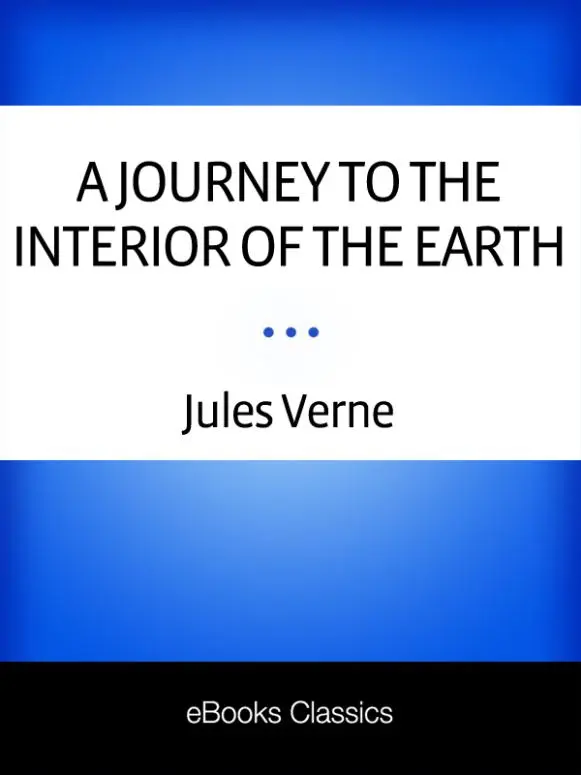A Journey to the Interior of the Earth

A Journey to the Interior of the Earth by Jules Verne, is part of the Pennsylvania State University, Electronic Classics Series, Jim Manis, Faculty Editor. Neither the Pennsylvania State University, Jim Manis, anyone associated with the Pennsylvania State University, nor Sony Connect Inc. or its affiliates assumes any responsibility for the material contained within the document or for the file as an electronic transmission, in any way.
Copyright © 2007 Sony Connect Inc. All rights reserved.
Copyright © 2001 The Pennsylvania State University (for the source electronic book file version).
ISBN 978-1-4340-0697-4
A Journey to the
Interior of the
Earth
By
Jules Verne
Originally published by Ward, Lock, &Co., Ltd., London, in 1877.
While the translation is fairly literal, and Malleson (a clergyman) has taken pains with the scientific portions of the work and added the chapter headings, he has made some emendations concerning Biblical references of his own, listed below:
III. "Pertubata seu inordinata," as Euclid has it.
XXX. cry, "Thalatta! thalatta!" the sea! the sea! The deeply indented shore was lined with a breadth of fine shining sand, softly
XXXII. hippopotamus. {as if the creator, pressed for time in the first hours of the world, had assembled several animals into one.} The colossal mastodon
XXXII. I return to the scriptural periods or ages of the world, conventionally called `days,' long before the appearance of man when the unfinished world was as yet unfitted for his support. {I return to the biblical epochs of the creation, well in advance of the birth of man, when the incomplete earth was not yet sufficient for him.}
XXXVIII. (footnote), and which is illustrated in the negro countenance and in the lowest savages.
XXXIX. of the geologic period. {antediluvian}
A JOURNEY TO
THE INTERIOR
OF THE EARTH
By
Jules Verne
PREFACE
The "Voyages Extraordinaires" of M. Jules Verne deserve to be made widely known in English-speaking countries by means of carefully prepared translations. Witty and ingenious adaptations of the researches and discoveries of modern science to the popular taste, which demands that these should be presented to ordinary readers in the lighter form of cleverly mingled truth and fiction, these books will assuredly be read with profit and delight, especially by English youth. Certainly no writer before M. Jules Verne has been so happy in weaving together in judicious combination severe scientific truth with a charming exercise of playful imagination.
Iceland, the starting point of the marvellous underground journey imagined in this volume, is invested at the present time with. a painful interest in consequence of the disastrous eruptions last Easter Day, which covered with lava and ashes the poor and scanty vegetation upon which four thousand persons were partly dependent for the means of subsistence. For a long time to come the natives of that interesting island, who cleave to their desert home with all that amor patriae which is so much more easily understood than explained, will look, and look not in vain, for the help of those on whom fall the smiles of a kindlier sun in regions not torn by earthquakes nor blasted and ravaged by volcanic fires. Will the readers of this little book, who, are gifted with the means of indulging in the luxury of extended beneficence, remember the distress of their brethren in the far north, whom distance has not barred from the claim of being counted our "neighbours"? And whatever their humane feelings may prompt them to bestow will be gladly added to the Mansion-House Iceland Relief Fund.
In his desire to ascertain how far the picture of Iceland, drawn in the work of Jules Verne is a correct one, the translator hopes in the course of a mail or two to receive a communication from a leading man of science in the island, which may furnish matter for additional information in a future edition.
The scientific portion of the French original is not without a few errors, which the translator, with the kind assistance of Mr. Cameron of H. M. Geological Survey, has ventured to point out and correct. It is scarcely to be expected in a work in which the element of amusement is intended to enter more largely than that of scientific instruction, that any great degree of accuracy should be arrived at. Yet the translator hopes that what trifling deviations from the text or corrections in foot notes he is responsible for, will have done a little towards the increased usefulness of the work.
F. A. M.
The Vicarage, Broughton-in-Furness
CHAPTER I
THE PROFESSOR AND HIS FAMILY
On the 24th of May, 1863, my uncle, Professor Liedenbrock, rushed into his little house, No. 19 Konigstrasse, one of the oldest streets in the oldest portion of the city of Hamburg.
Martha must have concluded that she was very much behindhand, for the dinner had only just been put into the oven.
"Well, now," said I to myself, "if that most impatient of men is hungry, what a disturbance he will make!"
"M. Liedenbrock so soon!" cried poor Martha in great alarm, half opening the dining-room door.
"Yes, Martha; but very likely the dinner is not half cooked, for it is not two yet. Saint Michael's clock has only just struck half-past one."
"Then why has the master come home so soon?"
"Perhaps he will tell us that himself."
"Here he is, Monsieur Axel; I will run and hide myself while you argue with him."
And Martha retreated in safety into her own dominions.
I was left alone.
1 comment